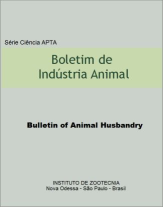Morphogenetic and structural responses of tropical plants submitted to defoliation
DOI:
https://doi.org/10.17523/bia.v72n4p321Keywords:
morphogenesis, structural characteristics, tillering, light interception, pasture methods.Abstract
Leaf emergence and elongation and the structure they confer to the forage canopy are quantified based on morphogenetic and structural characteristics of the canopy. The emergence and balance of tillers is known as tillering. Both morphogenesis and tillering confer the production potential to the pasture. This process is influenced by the intensity and frequency of defoliation. Pastures exhibit phenotypic plasticity when submitted to intense and frequent grazing in order to adapt to this adverse environmental condition. Furthermore, factors such as plant age and fertilization influence the growth pattern. A population with a young age profile or a fertilized pasture has more accelerated rates of morphogenesis and requires adjustment in pasture management. In addition to these factors, the seasonal distribution pattern of rain, temperature and photoperiod leads to variations in the growth pattern of pastures over the year. When these conditions are favorable for plant growth, the rates of morphogenesis are accelerated and adjustments in management are necessary. Thus, pasture management differs between the rainy and dry seasons, mainly because of the different growth patterns during these periods. Indeed, several factors influence the growth of pasture plants; however, appropriate maintenance of the leaf area index (LAI) of the pasture under continuous or intermittent stocking provides satisfactory results of pasture-based farming systems. Given the above, management targets considering morphogenetic parameters of the plant, in conjunction with the maintenance of an adequate LAI, show that continuously stocked pastures should be kept under optimal conditions for both plant growth and animal consumption. These conditions coincide with the maintenance heights of the forage canopy recommended for each species or cultivar. Similarly, under intermittent stocking, the optimal condition for pasture management, i.e., when regrowth should be interrupted, coincides with the time when the forage canopy intercepts 95% of incident light and the average rate of pasture accumulation is maximum. Thus, knowledge of the morphogenetic and structural responses of forage plants to changes in environmental conditions contributes to the establishment of pasture management strategies for the efficient use of forage resources.Downloads
Downloads
Published
Issue
Section
License
Os autores não serão remunerados pela publicação de trabalhos, pois devem abrir mão de seus direitos autorais em favor deste periódico. Por outro lado, os autores ficam autorizados a publicar seus artigos, simultaneamente, em repositórios da instituição de sua origem, desde que citada a fonte da publicação original seja Boletim de Indústria Animal. A revista se reserva o direito de efetuar, nos originais, alterações de ordem normativa, ortográfica e gramatical, com vistas a manter o padrão culto da língua e a credibilidade do veículo. Respeitará, no entanto, o estilo de escrever dos autores. Alterações, correções ou sugestões de ordem conceitual serão encaminhadas aos autores, quando necessário. Nesses casos, os artigos, depois de adequados, deverão ser submetidos a nova apreciação. As opiniões emitidas pelos autores dos artigos são de sua exclusiva responsabilidade. Todo o conteúdo deste periódico, exceto onde está identificado, está licenciado sob a Licença Creative Commons Attribution (CC-BY-NC). A condição BY implica que os licenciados podem copiar, distribuir, exibir e executar a obra e fazer trabalhos derivados com base em que só se dão o autor ou licenciante os créditos na forma especificada por estes. A cláusula NC significa que os licenciados podem copiar, distribuir, exibir e executar a obra e fazer trabalhos derivados com base apenas para fins não comerciais.













